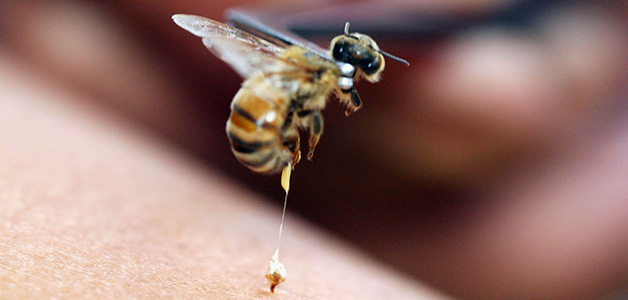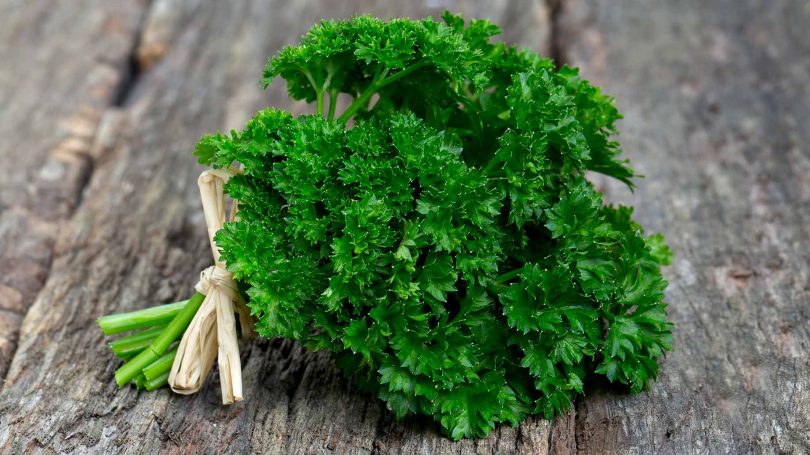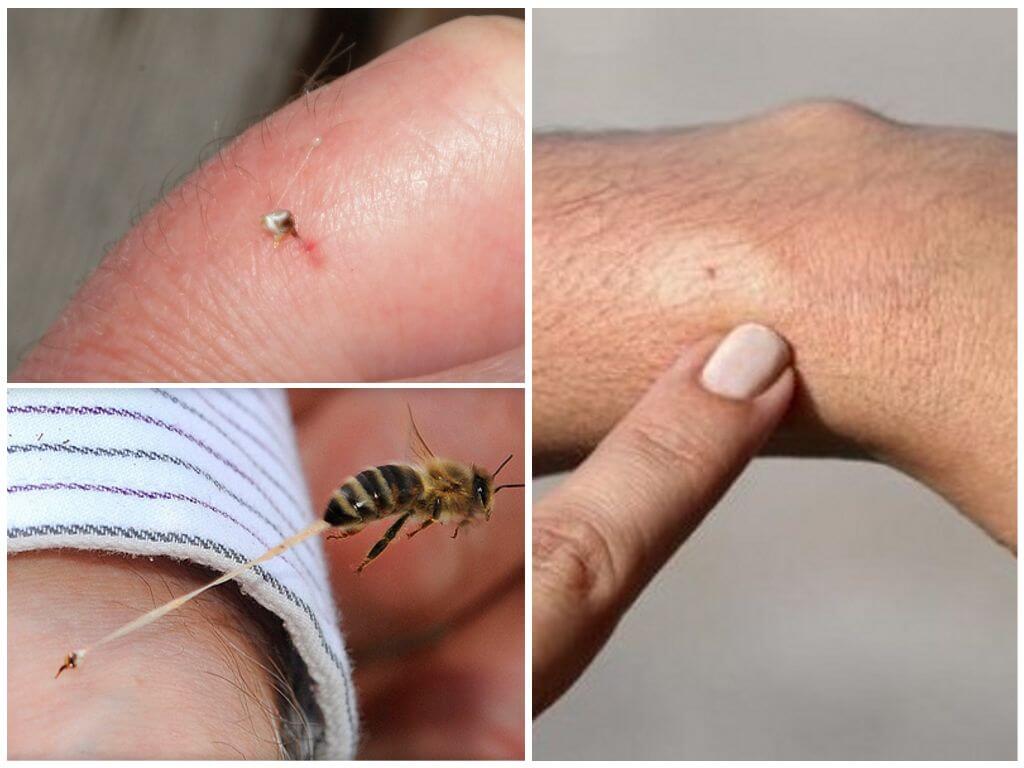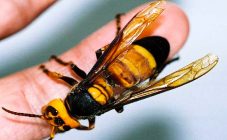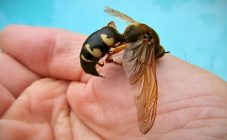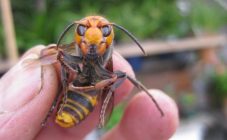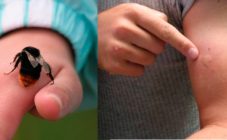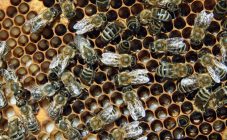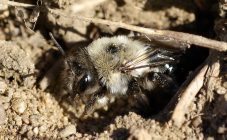Content:
Bees play an important role in the ecosystem by pollinating plants. These hardworking Hymenoptera are the only insects that produce a useful food for humans (honey). But they are also considered dangerous. A bee sting is painful. During the bite, poison is released from the sting. In people with allergies, this substance causes an acute negative reaction in the body. People without allergies tolerate the sting without too many problems. This is provided that there are few bites. If a person is attacked by a swarm of Hymenoptera, they can sting to death. But even if one bite happened, it is necessary to take measures to remove the swelling and painful burning sensation.
Description of the bite
What a bee sting looks like is known to people who have encountered insects that have a yellow-black color. The appearance of an injury caused by a flying honey collector can be different. It depends on the part of the body that the bee stung. If an arm or leg, back is injured, then the injured area will be weak. First, slight redness appears, then a noticeable swelling or small, dense bump. 5-10 minutes after being stung by a bee, the area of the skin near the sting turns white. The place where the sting has penetrated is a reddish round wound. The tumor lasts from 1 to 20 hours, after which it quietly subsides.
Another thing is if the bee sting fell on the delicate tissues of the face (eyelids, eye areas, lips, mucous membranes), neck, head, armpit, etc. In this case, severe swelling appears. The eye may swell so that it cannot see. Redness is observed. This swelling lasts from 36 hours to 8 days.
Symptoms
- The person feels a piercing instant pain, as with an injection.
- The pain is replaced by a burning sensation.
- The skin near the wound tingles. This is due to the presence of bee venom (apitoxin) in the tissues.
- The place where the sting was stuck, and the area next to it begins to itch after 15-20 minutes.
- Itching and pain occurs when you touch the affected area.
- The inconvenience disappears as soon as the swelling disappears.
The strength of the painful sensations depends on the person who has been bitten by the bee. In particular, on how susceptible he is to pain. People with a high pain threshold react calmly to an incident. People with a low threshold and children can faint from the bite. Allergy sufferers who cannot tolerate apitoxin can also lose consciousness.
Symptoms of a bite in allergy sufferers
- Sharp pain throughout the body.
- Darkening in the eyes.
- Increased body temperature.
- Chills.
- The affected area of the skin turns red, swells, pain and burning are felt.
- The likelihood of urticaria is high.
- The face swells.
- A noise appears in my head.
- Blood pressure starts to rise and fall.
- It is difficult for a person to breathe.
- Vomiting, convulsions, fainting may occur.
The listed symptoms are signs of a severe allergic reaction.In milder cases, allergy is manifested by hives, pain throughout the body, and edema.
What will help with a bee sting
Helping a person without allergies
After the bee stings, you should take the necessary measures. The sting is gently removed with tweezers. The place is treated with hydrogen peroxide, potassium permanganate solution, Chlorhexidine or other disinfectant. Next, you should apply ice or lower a part of the body in cold water. The cold will prevent the spread of the tumor and relieve pain.
To prevent an allergic reaction, the victim is given a tablet of Suprastin, Diphenhydramine or Loratadin. To quickly remove apitoxin from the body, a person must drink plenty of fluids. Warm sweet tea, compote, milk or plain water will do. You must not drink alcohol. This can provoke allergies or suppuration of the injured area.
It is allowed to apply creams or ointments to relieve itching and redness. These include:
- Fenistil;
- Akriderm;
- Rescuer;
- Levomekol;
- Ichthyol ointment;
- Vishnevsky ointment;
- Hydrocortisone, etc.
Help for allergy sufferers
If a bee has bitten a person who does not tolerate apitoxin, then he is urgently given antihistamines. The recommended dosage should be doubled. Among these medicines:
- Loratadine;
- Suprastin;
- Diphenhydramine;
- Zodak;
- Cetrin;
- Tavegil;
- Claritin, etc.
If a person fainted, family members should call the emergency room. A conscious person should be taken to a medical facility.
Traditional methods
Onion compress
You can reduce tissue swelling with an onion compress. The onion is peeled and finely chopped, crumpled. The resulting gruel is cooled for 5 minutes in the freezer, wrapped in one layer of gauze and placed on the problem area. Onions have a wound healing effect and kill pathogenic microbes.
Aloe leaves
The fleshy leaves of the aloe are cut so that the flesh can be applied to the swollen area. The juice soothes damaged tissues, relieves itching and reduces swelling.
Parsley and plantain
Greens are able to heal wounds and kill harmful bacteria. Crushed leaves of parsley and plantain are applied to the bite site and fixed with a gauze bandage. Fresh plants are applied every 30-50 minutes. This folk method will avoid inflammation and suppuration of the damaged area.
Decoction of garden chamomile
Both fresh plant and dried material are used. Chamomile is placed in a bowl, poured over with hot water and put on gas. The broth boils for 15-25 minutes. Then it is cooled. A gauze bandage soaked in broth is applied to the swollen area. The broth soothes itchy tissues, removes redness and reduces swelling.
Chilled oil
Chilled oil helps to relieve inflammation and reduce swelling. Both sunflower and olive or coconut are suitable. The liquid is poured into a small container. The container is placed in the freezer. After 5-10 minutes, the oil is taken out and applied in a circular motion, rubbing into the affected area.
Death after bee attack
The question "How many bee stings are fatal to humans?" interests many. It all depends on the poison in the insects. Apitoxin is produced by bees in special glands. Each individual has a reservoir of poison. It contains about 0.007-0.009 g of a poisonous substance. If a bee stung, then approximately 0.008 g of apitoxin enters the body. A healthy person can handle this amount without problems.
If a person has been bitten by bees in large numbers, then a fatal accident may occur. Experts have found that for a strong adult man a lethal dose of bee venom is 0.15-0.2 g. This amount of poison is left by 200-450 insects.For women and children, 150-250 one-time bee stings are enough to die. Death in this case is recorded due to severe intoxication.
Bee stings the head of the penis
What happens if a bee stings the head of the penis? Due to the fact that the head has thin and delicate skin, the pain will be very strong. The tissues will instantly swell. In some cases, there is an increase in the reproductive organ 2-3 times. Moreover, any touch of the penis causes a burning sensation and stitching painful sensations. Help consists in removing the sting from the head, treating the skin with disinfecting ointments, ice, soothing compresses (from aloe, chamomile).
The consequences of a bee sting in the penis were taken as a basis by the advocates of apitherapy, suggesting in this way to increase male dignity. Apitherapy - treatment with bee stings. In order for the size of the penis to increase, a course of Hymenoptera bites is required. As a result, according to the adherents of the method, the cavernous tissue gradually grows, due to this, the penis will increase. Apitherapy has a positive effect on erection.
The bee stings once
A black and yellow honey collector can only sting a person or an animal once. Then he dies. Why does a bee die after it stings? The point is in the structure of the insect's body. The back of the creature is represented by a stinging apparatus. It consists of poisonous glands, a sting, a reservoir of apitoxin.
The blade size is only 1.5-2 mm. It looks like a tiny, slightly flattened, sharp needle with notches on one side. The blade can be compared to a one-handed saw. The sting enters the skin smoothly, cutting through the top layer. But the bee can no longer get it back. It's all about the barbs that get stuck in the fabric like hooks. The insect is making every effort to fly away after the incident. As a result, it makes a strong jerk and flies away. In this case, the stinging apparatus and part of the viscera remain at the site of the bite. The fleeing bee gets wounds, in which there is no chance of survival. She dies after 1-5 minutes.
How to relieve bee sting pain
There are several ways to relieve pain. Among them:
- Place a freezer ice item or a bag of cocktail ice cubes on the affected area. The cold blocks the sharp pain and prevents the swelling from spreading.
- The opposite way is to warm the bite site, for example, with a clean cloth moistened with hot water.
- Activated charcoal will help remove pain and neutralize poison. Several tablets should be ground into powder and mixed with water. The resulting mass is applied to the skin and fixed with a gauze bandage.
- Acetylsalicylic acid effectively fights pain. The tablet is ground and mixed with water. Gruel is rubbed into the damaged area.
The consequences of a bee sting
- Allergy sufferers risk dying from Quincke's edema or anaphylactic shock after a bee sting.
- In a person with a strong immune system, a bee sting should not cause any unpleasant consequences. However, if the wound is not treated in time, it will fester.
- Insects carry pathogens, so there is a chance that an infection can enter the body through the wound. As a result, the temperature rises, the victim feels weakness, loss of strength, body aches. In this case, you should see a doctor.
- Consequences in the form of inflammation of the eyelids, conjunctivitis are observed if a bee stings in the eye. The patient should consult an optometrist.
A bee can sting any person. The main thing is to respond correctly to trouble. If you are allergic to apitoxin, you should immediately give the victim an increased dose of an antihistamine and take him to the nearest hospital. A person without allergies tolerates a meeting with a bee without any problems. But in this case, it is also important to completely remove the sting with tweezers, disinfect the wound with a solution of manganese or hydrogen peroxide. You can relieve a throbbing tingling pain with a cold, a tablet of charcoal or acetylsalicylic acid.
